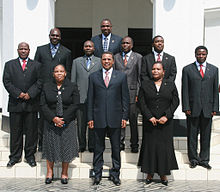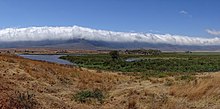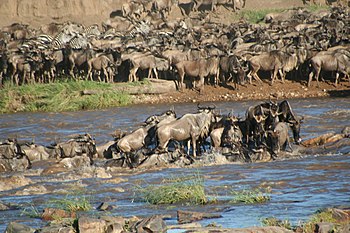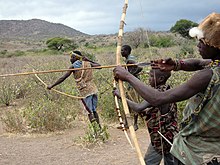Tanzania
Tanzania, officially the United Republic of Tanzania (in Swahili Jamhuri ya Muungano wa Tanzania; in English, United Republic of Tanzania), is a country located on the east coast of Central Africa. It borders to the north with Kenya and Uganda, to the west with Rwanda, Burundi, the Democratic Republic of the Congo, with which it does not have a land border, since Lake Tanganyika divides them, with Zambia, Malawi (with which it maintains a territorial claim on Lake Malawi), Mozambique and to the east with the Indian Ocean. Its capital is Dodoma and its most populous city is Dar es Salaam, the seat of government and center of political power in the country. The name of the country comes from the union of the words "Tanganyika" and "Zanzibar". The current United Republic of Tanzania was born on April 26, 1964, when Tanganyika, which had formed the German colony of German East Africa and then passed into British hands at the end of World War I, became independent on December 9, 1961 and the Republic of Zanzibar, which achieved its independence from the British crown on December 10, 1963, uniting into a single State.
Tanzania is characterized, thus differentiating itself from its neighbors, by its resistance to British colonial domination and by not recognizing English as an official language. On the other hand, the country has promoted a series of reforms that, although they are still to be completed; It proposes its own independent, autonomous and sovereign State based on African values, hence the importance of Swahili as the only official language as a way of uniting the Tanzanian people".
History
Prehistory
Some of the oldest human settlements have been found in Tanzania, including those in Olduvai Gorge where the oldest human footprints (3.6 million years) have been found at Laetoli. Remains of Australopithecus and Paranthropus were found in this gorge.
Indian Traders
Tanzania has long been visited by foreign traders, first Persians and then Arabs (who called mainland Tanzania Azania, 'Land of the Blacks'). These were especially looking for spices, slaves and ivory, and over time they ended up founding colonies on the coast such as the island of Zanzibar, Kilwa or Pemba, which served as a port for embarking and disembarking all kinds of merchandise and finally ended up becoming a series of small independent sultanates inhabited by mixed Arab-African people. In the 16th century, Portugal conquered Zanzibar and ruled the region for two centuries. In the 18th century the coast was annexed by Oman, though in 1861 it became independent as a sultanate with its capital at Zanzibar, ruled by the Omani dynasty. In the following decades, Zanzibar fell into decline due to competition from European traders and their domains on the continent's coasts had to be gradually evacuated. Finally, the island of Zanzibar became part of the British Empire in 1896, after a 38-minute war, the shortest in history.
European colonialism
Portuguese
The first westerners to reach the present territory of Tanzania were the Portuguese. At the end of the 15th century, Portugal sought to establish itself in particular in the search for gold from the Kingdom of Quiloa that came from the interior. Portugal conquered Zanzibar and Quiloa and ruled the region for two centuries. Portugal has allied itself with various tribes, namely the Zimba, thus ensuring some stability on the continent and military support. In Zanzibar, the local king, who was a subject of the king of Portugal, was kept by paying tribute.
The entire coast and islands of Pemba (where bullfighting rituals are practiced today) and the Mafia up to the present border of Mozambique were dominated by the Portuguese until the invasion of Oman in 1698. Portugal was present until 1730, but was withdrew to what is now Mozambique.
Germans and British
The mainland of present-day Tanzania was awarded to Germany during the Berlin Conference (1884-1885). By virtue of this, the colony of German East Africa, also known as Tanganyika, was created, which included, in addition to most of Tanzania, the current states of Rwanda and Burundi. In 1905, the rebellion of the maji maji against German colonial rule was resolved with widespread repression of the population, mass killings, and famine in which 300,000 Africans perished.
German East Africa was the only German colony in Africa to resist the British invasions during World War I thanks to the military genius of General Paul von Lettow-Vorbeck, but at the end of the war, after the signing of the Treaty of Versailles (1919) most of Tanganyika was handed over to Britain, and Rwanda and Burundi to Belgium.
Independence
Tanganyika was administered by the British until 1961, when it peacefully became independent and a republic under the moderate Julius Kambarage Nyerere, leader of the Tanganyika African National Union (TANU). For its part, Zanzibar was evacuated by the British two years later and became an independent country under the government of Sheikh Abeid Amani Karume and the leftist Afro-Shirazi party, after overthrowing the sultan. Tanganyika and Zanzibar negotiated a unification of both states that received the name of Tanzania, carried out in 1964.
Eager to hasten the emancipation of Africans from the Western world, inspired by the communist experiences in China, Nyerere committed himself to a socialist policy. In February 1967, in the Arusha Declaration, he defined the principles and doctrines that he wanted the country to follow. According to Nyerere's ideal, African socialism should lead to the creation of an egalitarian, just and supportive society, which finds in its own resources the means of its self-sufficiency. Education is the first priority. It must be said that there was an urgent need in this field: at that time, Tanzania only produced 120 graduates a year.
The first concrete measures to apply this policy were not long in coming. Major industries and service companies are nationalized, taxes are raised to ensure a greater distribution of wealth, and racial discrimination is suppressed. The biggest changes occurred in agriculture, the country's main economic sector. Village communities called Ujamaas, or brotherhoods, were organized on collectivist principles. Financial incentives encourage the formation of cooperatives.
During these years, Tanzania received aid from China, despite being a developing country. With Chinese help, the TAZARA railway from Dar-es-Salaam to Zambia was built in 1975.
In foreign policy, Tanzania supports the Lumumbist guerrillas in the Congo and the Organization for African Unity establishes its headquarters in Dar es Salaam, and several revolutionary movements are represented in the country (ANC, ZANU, SWAPO, MPLA and FRELIMO). At the same time, relations with Western countries deteriorated; in 1965 Tanzania severed relations with the United Kingdom and expelled British troops from the country in reaction to London's support for a segregationist regime in Rhodesia, while West Germany severed its own relations with Tanzania after the opening of an East German embassy in the country. Economic aid from some Western countries was cut off. On the other hand, the Portuguese colonial forces bombarded the south of the country to cut off the supply routes of the Mozambican FRELIMO, supported by the government of Julius Nyerere.
Despite economic difficulties, the country is at peace and receives many refugees from neighboring countries at war or fleeing the Idi Amin Dada regime in Uganda. Nyerere refused to allow the administration's Africanization policy to favor only Tanzanians and allowed foreigners access to public jobs. Many also obtained Tanzanian citizenship, including white refugees.
In 1979, Tanzania declared war on Uganda, after Uganda, led by Idi Amin, invaded and tried to annex Kagera, a northern province of the country. Tanzania first drove out the invading forces and then invaded Uganda itself. On April 11, 1979, Tanzanian forces along with Ugandan and Rwandan guerrillas seized the capital, Kampala, and forced the dictator Idi Amin into exile. The war, however, ruined Tanzania.
In October 1995, Tanzania held its first multiparty elections. The previous ruling party, Chama Cha Mapinduzi (CCM), handily won the elections and its candidate Benjamin Mkapa was sworn in as President of the United Republic of Tanzania on November 23, 1995. In November 2015 John Magufuli was elected President for a period of five years. Magufuli passed away in 2021 and was succeeded by Vice President Samia Suluhu.
Government and politics
The Revolutionary Party, the successor to Nyerere's TANU, and its philosophy of African socialism maintain dominance over the government. In 1977 the creation of other parties in Tanzania was approved, a fact that was finally defined under the government of Ali Hassan Mwinyi, successor in 1985 to Nyerere.
The form of government in Tanzania is a Republic with a president, elected for a five-year term, and two vice-presidents. The vice-presidents must be one, the President of Zanzibar, and another, the Prime Minister. The National Assembly is 291 members and the Zanzibar House of Representatives 75 members.
The current president is Samia Suluhu.
Human Rights
In terms of human rights, regarding membership of the seven bodies of the International Bill of Human Rights, which include the Human Rights Committee (HRC), Tanzania has signed or ratified:
Territorial organization
The administrative division consists of 31 regions.
Zanzibar and Tanganyika maintain different legal systems since their federation, which has brought various problems to the justice of this country (for example, it is necessary to request extradition to send prisoners from one area to another). While the laws in force in Tanganyika are heirs to those imposed by the British colonists, in Zanzibar they are strongly influenced by sharia or Islamic law. Tanzania currently claims a sovereign part in Lake Malawi, but the Republic of Malawi opposes said territorial claim, in this conflict Mozambique, which also has territory in said lake, has shown itself as a mediator between Malawi and Tanzania.
Geography
Tanzania is a country in East Africa with an area of 947,300 km². The bordering countries are Kenya and Uganda to the north, Rwanda, Burundi and the Democratic Republic of the Congo to the west and Zambia, Malawi and Mozambique to the south. Seen from sea level, Tanzania forms a plateau of about 1000 meters of altitude that extends to the lakes Malawi and Tanganyika that starts from the valley of the Great Rift, which includes the lakes Natron, Eyasi and Manyara that separates the mountain range north, dominated by Kilimanjaro, near the border with Kenya.
Semi-arid climatic conditions in the north and the presence of the tsetse fly in the central and western regions have led the population to cluster in the rest of the country.
In the Arusha region in northern Tanzania, we can see the remains of the Ngorongoro crater. The caldera-shaped Ngorongoro crater, formed 2.5 billion years ago, has become famous because with its diameter of 20 km and its surface area of around 300 km² it is a natural paradise, an equatorial Noah's ark where conditions Climate conditions allow animals to live year-round, from hippos to pink flamingos that inhabit nearby Lake Makat.
The center of the country is made up of a plateau bathed by rivers that flow into the Indian Ocean in the east. The maritime front of the country is formed by a coastal plain in which we find the Zanzibar archipelago formed by three main islands: Unguja, Pemba and Mafia.
In Tanzania we find numerous volcanoes but only one of them is active, the Oi Onyo Legaï. The highest mountain is Kilimanjaro, already mentioned before, which is also a volcano and the highest mountain in all of Africa.
Ecology
Tanzania has approximately 29 per cent of large mammal species in Africa, which are in reserves, conservation areas, marine parks and seventeen national parks scattered over more than 42,000 square kilometres, representing approximately 38 per cent of the national territory. (1) (2) The wealth of Tanzania’s fauna is considered “without the same in all of Africa” and “the country’s first hunting observatory” The Serengueti National Park – the second largest in the country, with 14,763 square kilometers – is located north of Tanzania and is famous for its large migratory packs of luus and zebras, while enjoying the reputation of being one of the great wonders of nature in the world. The Ngorongoro Conservation Zone, created in 1959, is a UNESCO World Heritage Site (3) and is inhabited by the Masai people. (4) The Ngorongoro crater is the largest intact boiler in the world. (5) (6)
National parks are also part of Tanzanian wetlands. Wild animals tend to graze in these wetlands, particularly those water-loving species, such as hippos, aquatic antelopes, common facokers, elephants, crocodiles and sitatunga African antelopes, as well as aquatic birds such as flamingos and ducks. (7)Savannah
Most of Tanzania's territory falls within the savannah biome. WWF distinguishes seven savannah ecoregions in Tanzania:
- Mosaic of jungle and savannah of the Lake Victoria basin in the northwest end, between Lake Victoria and Rwanda.
- Tanzanian arbustive savannah, Serengueti volcanic meadow and Kenyan arbusive savanna in the northeast.
- Treeed savannah of eastern miombo in the south.
- Treeed savannah of central Zambeze miombo in the west.
Mountain
Mountainous regions are covered with shady forests and, at higher altitudes, montane meadows:
- East African mountain range in the northeast.
- Mounted forest of the Albertina fault in the west.
- Rift Eastern Arc Jungle in the east and center.
- East African mountain range in the northeast.
- Mountain Mosaic meadow and jungle of the Southern Rift in the southwest.
Coast
The coasts are covered by coastal forests (Zanzibar Coastal Mosaic Forest in the north and center, and Inhambane Coastal Mosaic Forest in the south) and mangroves (East African mangrove).
Flooded Grasslands
The ecology of Tanzania is completed with several enclaves of flooded grasslands:
- Salobral of East Africa (north and centre).
- Flooded slope of Zambeze (center).
Epidemics
The "Chinkungunya," virus, whose name means "squirm," in the Kimakonde language first appeared in this country in 1952.
Economy
Tanzania's economy is fundamentally based on agriculture, although only 4% of the country's total area is arable, this sector represents half of GDP, 85% of exports and, in addition, employs 90% of the working class. The country's industry is basically limited to the processing of agricultural products.
Inland fishing represents an important economic activity as Tanzania has an exceptional amount of freshwater resources that cover 6.5% of the total land area and account for about 80% of the catches. Lake Victoria, the largest in Africa, hosts the continent's largest production fisheries due to the enormous growth of Nile perch. Annual catches of Nile perch have accounted for about half of the total annual inland production of the Nile perch. country both for the domestic market and for the export of frozen fillets and fresh refrigerated products. Very significant amounts -but largely unrecorded- of locally produced products are also exported to neighboring countries.
Tanzania also has significant natural resources, including gold mines (such as Tulawaka) and natural gas reserves in the Rufiji delta. Mainly Tanzania produces: coffee, cotton, sisal, tea and diamonds. In recent years, tourism has been one of the largest sources of income for the country.
It is a country of origin, transit, and destination for men, women, and children subjected to forced labor, especially children in domestic servitude, farms, mines, and quarries, and the sex trafficking of women.
The issuance of postage stamps, mainly for international collecting, is also an important source of income for its economy.
International financial organizations have for many years lent funds to rehabilitate Tanzania's dilapidated infrastructure network, however this became a problem as they had to repay the loans plus interest. This situation was resolved on January 5, 2006, when the World Bank, the International Monetary Fund and the African Development Bank canceled the debt of 19 countries (including Tanzania) for being the poorest and most indebted countries in the world (HIPC). This decision was made based on a proposal made by the United Kingdom at the G8 conference in Gleneagles (Scotland).
The country has nearly completed its transition to a liberalized market economy, even though the government retains ownership of all land, which can be leased for up to 99 years, and has a presence in sectors such as telecommunications, banking, energy, and mining. The open door policy of the Tanzanian Investment Center, aimed at attracting foreign investors, has been detrimental to local productions that cannot compete due to their scarce capital and business experience. The introduction of foreign companies is producing a phenomenon of forcible evictions of villagers and expulsion of peasants from the land. According to a work by S.A.H.Ri.N.G.O.N. and LEDECO, inadequate and unsustainable policies, inappropriate technologies and insufficient infrastructure in rural areas - together with desertification, deforestation and the high incidence of pests and diseases - have produced and reproduced a sustained increase in poverty, food insecurity and stagnant development.
Demographics
There are 120 groups of Bantu origin that bring together the majority of the population and there are no rivalries between the groups. Swahili and English are spoken. A quarter of the population lives in cities. 78.2% of the population is literate, however, there is a high level of dropout in secondary education. Primary education is free. 66% have access to health services.
Tanzania has the largest population in East Africa and a very low population density, with ⅔ of the population being rural. A high total fertility rate of 4.8 children per woman can be observed, with an annual growth of almost 3% in the country. The mortality rate is very high (7.6 per 1,000 inhabitants) due to early and frequent pregnancies and the lack of maternal health services among poor and rural women.
The density of doctors is 0.03 per 1000 inhabitants. The mortality rate is high, in children mainly due to malaria and among adults due to HIV. 5% of the adult population has HIV-AIDS (13th place in the world ranking), 1.4 million inhabitants live with HIV-AIDS (6th place in the world ranking) and in 2016 33,000 died from this disease (7th place in the world). the world ranking). 43.74% are concentrated between 0 and 14 years and the average age is 17.6 years. 14% of children are malnourished. School life expectancy does not exceed 8 years and child labor is 21% of the population between 5 and 14 years of age.
Languages
There are 127 languages in Tanzania. 90% of the population speaks a Bantu language; In addition, Nilotic languages, Cushite languages and, mainly in Zanzibar, Arabic are spoken. De jure there is no official language, but Swahili is the national language, used as both a lingua franca and an administrative language, and thus can be considered a de facto official language. During the colonial era, English was used as an administrative language, but now it is no longer used in public administration, parliament, or government, and is therefore not a genuine official language. Thus Tanzania is one of the few African countries in which a vernacular language gained importance over the colonial language. Under Tanzania's official language policy, as promulgated in 1984, Swahili is the language of the social and political sector, primary education, and adult education; English is intended for secondary and university education, for higher courts and for technology. Although the use of English in Tanzania is promoted by the British government with large amounts, English was gradually suppressed by society Tanzania in the past decades. For example, in the 1970s, Tanzanian students normally spoke English to each other; now they almost only speak Swahili. Even in high school and college classes, where officially only English is allowed, Swahili or a mixture of Swahili and English is sometimes used.
Swahili is the mother tongue of the Bantu who live in Zanzibar and the neighboring coasts of Tanzania; although Swahili is Bantu in structure and origins, its vocabulary spans many languages. Like English and Arabic, it has become the lingua franca of central and eastern Africa; the first language of many people is one of the local languages. MoUs have been signed with Germany for the study of German.
The most widely spoken languages are Swahili and English; the second is the most used in trade. Likewise, there are a large number of tribal languages such as Aasax that reflect the ethnic diversity of the nation. Beyond the large populations, English speakers are in short supply, unlike in Kenya.
- Literacy
They read and write with more than 15 years: Swahili, English or Arabic. Of the total population, 78.2% is literate. In men, it is 85.9%, while in women, it is 70.7%.
Culture
Ethnicities
Of the hundred or more Tanzanian ethnic groups, most are of Bantu origin. The Arab influence on the islands of Zanzibar and Pemba is evident in its people, a mix of Sirazis (of Iranian origin), Arabs, Comoerenses (originating from the Comoro Islands) and Bantu (the predominant ethnic group).
The Asian population constitutes a significant minority, especially in towns and cities. Europeans (descendants or expatriates) make up a smaller minority and are mainly concentrated in Dar es Salaam. Most of the inhabitants that do not correspond to the Bantu, belong to the Maasai (whose language is Nilotic), and inhabit the northeastern part of the country.
Religion
The majority of the population professes Christianity, Islam and also indigenous religions. The bulk of Muslims are concentrated along the coast and on the islands. Compared to Islam, Christianity took a long time to make its mark, and even then (during the 19th century) it was only practiced various inland tribes. Today, numerous clans remain that follow none of the major religions and revere the ancient spirit of their cult.
The Maasai believe in the god Engai and in his messiah Kindong_oi, progenitor of the priests of their faith. At present, and according to what is stated, there is no religious bias in the civil and political administration of the country.
Music
Tanzanian music and dance dominate much of East Africa. Fast-paced and famous for its catchy lyrics, the tune of Tanzanian Swahili is kept alive by the thriving world of band music and dance. Remmy Ongala is the best known name outside the country.
Zanzibar is the heart of the remarkable poetic and musical tradition known as taraab. The goddess of this captivating style, Siti Bint Saad, was the first African singer to make recordings as early as 1928.
Freddie Mercury, the legendary singer of the group Queen, was born and spent the first years of his life in the country.
Gastronomy
There is no appreciable difference between Kenyan and Tanzanian food. As in Kenya, choma (grilled meat) has spread everywhere, especially in restaurants with bar service.
However, the coast, along with the islands of Zanzibar and Pemba, offers a decent selection of traditional Swahili seafood-based dishes. The national drink is Safari Lager beer, and the local liquor can be defined as a lethal concoction of white rum: konyagi.
Sports
Contenido relacionado
Evaristo
Jump
Epigraphy

















